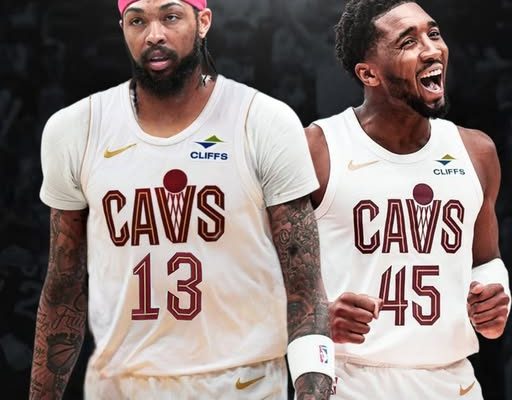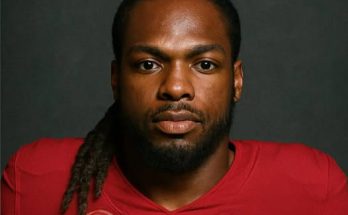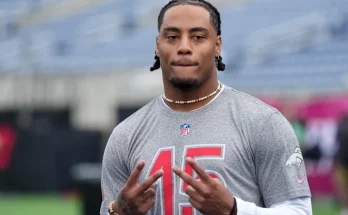The NBA trade landscape has once again been shaken by a potentially seismic proposal, one that could redefine the trajectories of not one but three franchises: the Cleveland Cavaliers, the Toronto Raptors, and the New Orleans Pelicans. The trade idea making waves? Brandon Ingram heading to the Cleveland Cavaliers, with star point guard Darius Garland being rerouted not to New Orleans, but to Toronto. It’s the kind of three-team exchange that both raises eyebrows and prompts serious basketball curiosity. Could this be the move that catapults the Cavaliers to true Eastern Conference contention? Could the Raptors finally be securing their next franchise point guard? And is New Orleans quietly resetting its priorities in a shifting Western Conference?
Brandon Ingram, the 6’8” forward with All-Star pedigree and a versatile offensive skill set, has quietly become one of the most intriguing names on the trade market. Ever since Zion Williamson’s injuries began disrupting the Pelicans’ long-term plans, Ingram has subtly carried more than his share of the offensive burden, often being the go-to creator in late-game situations. But it’s become increasingly clear that New Orleans may be interested in reshaping the roster around Zion—or moving on entirely from a core that hasn’t delivered postseason consistency. Enter the Cavaliers, a franchise now restructured around Donovan Mitchell, Evan Mobley, and Jarrett Allen, and one that may be seeking a more natural offensive complement on the wing.
The fit for Ingram in Cleveland is, on paper, enticing. The Cavaliers lacked consistent scoring from the forward spot all of last season, and though Isaac Okoro’s defense is invaluable, the offense lagged behind in big moments, particularly in the playoffs. Ingram brings a polished mid-range game, the ability to create his own shot, and the experience of being a go-to scorer on a playoff team. With Donovan Mitchell as the focal point of the backcourt, Cleveland might prefer a forward who can play off the ball, run pick-and-rolls when necessary, and space the floor with gravity—not necessarily another dominant ball-handler like Garland.
Darius Garland, meanwhile, is no slouch. A dynamic playmaker and one of the quickest guards in the league, Garland has long been the heartbeat of Cleveland’s offense. But with Mitchell assuming more of the playmaking duties and Cleveland intent on doubling down on its defensive identity, it’s clear that the Mitchell-Garland pairing has not brought the desired results in the postseason. Trading Garland while his value remains high may allow Cleveland to retool around a more traditional offensive hierarchy. Garland averaged 18 points and 6.5 assists per game last season, but there were clear moments when Mitchell and Garland overlapped in a way that minimized both of their strengths. In essence, both players need the ball. Mitchell will likely stay. Garland may not.
Toronto’s inclusion in the deal is where things get even more interesting. The Raptors have long been without a true point guard since the departure of Fred VanVleet. Scottie Barnes is blossoming into a versatile star, but he thrives more as a connector and switchable defender than as a floor general. Bringing in a player like Garland could immediately change the complexion of the Raptors’ offense. Garland’s elite handle, ability to shoot from deep, and creative vision would give Toronto an offensive focal point around which to build. Surrounded by lengthy wings and supported by a development system known for maximizing talent, Garland could thrive in Toronto in a way that gives him full control of a team’s tempo—something he shared in Cleveland.
There are, of course, questions about fit and direction for all teams involved. For Cleveland, giving up Garland would mean a significant philosophical shift. He was the face of the post-LeBron rebuild and remains a fan favorite. But the addition of Brandon Ingram would give Cleveland size, shooting, and offensive versatility they currently lack on the wing. Ingram’s contract, which runs through 2025, also aligns with Mitchell’s current deal. It gives the Cavaliers a two-year window to see what a Mitchell-Ingram-Mobley trio can accomplish in the Eastern Conference.
For Toronto, Garland would represent a firm commitment to a new identity. The team has drifted in recent years without a clear offensive engine, and while Barnes continues to improve, the Raptors have lacked consistent shooting and playmaking from the guard position. Garland solves that. He may not be an elite defender, but with Toronto’s length and ability to switch, he can be protected on that end while giving the team a clear offensive roadmap. Pascal Siakam’s departure already signaled a new era. Adding Garland cements it.
The Pelicans, in this hypothetical, come away with cap flexibility and perhaps a fresh start. Ingram’s departure would clear a path for Zion Williamson to be the undisputed centerpiece. It could also allow for the development of younger players like Dyson Daniels and Trey Murphy III. Whether the Pelicans receive assets or picks in this proposed deal is up for debate, but moving on from Ingram might signal New Orleans’ belief that their current core has reached its ceiling.
There are financial considerations too. Ingram is owed over \$36 million this upcoming season, while Garland is set to begin his \$197 million rookie max extension. Toronto, a team that’s traditionally careful with long-term financial commitments, would be investing significantly in Garland, but the upside could justify it. Cleveland would take on Ingram’s shorter deal, potentially offering them more flexibility in two seasons if the pairing doesn’t work. For New Orleans, cap space and picks may be more valuable than another star-level player in return.
The ripple effects around the league would also be significant. If Cleveland becomes a top-four seed contender with a wing-heavy offensive approach, it may force teams like the Knicks, Sixers, and Heat to re-evaluate their rotations. For Toronto, a successful season with Garland could suddenly push them into the playoff picture in the East and change the dynamics of a conference many view as top-heavy. For New Orleans, stepping back could position them for a more competitive draft cycle or open up space to make a more fitting deal around Zion.
There’s also a chemistry factor. Garland and Mitchell, despite being talented individually, haven’t quite clicked as expected. Too often in the playoffs, one of them disappears while the other goes off, but rarely do they dominate in tandem. Ingram, by contrast, has shown he can play alongside other stars, particularly in his chemistry with CJ McCollum and Zion (when healthy). His ability to defer or attack makes him a smoother fit next to a high-usage guard like Mitchell. Ingram is also quietly one of the league’s most efficient scorers in isolation and late-game situations—something the Cavaliers have sorely lacked outside of Mitchell.
Public reaction to this potential trade is expectedly split. Cavaliers fans are understandably hesitant to move on from a homegrown star like Garland, but many recognize the need for a better balance on the roster. Raptors fans, on the other hand, might be thrilled with the addition of a dynamic guard who gives their offense a legitimate identity. Pelicans fans may grieve Ingram’s departure, but also recognize that stagnation is worse than a bold step toward reinvention.
NBA insiders and executives would likely praise the creativity of the deal. It’s rare to see a trade involving three All-Star-level talents across three different markets, each with a unique objective. The deal reflects how interconnected today’s NBA has become—where cap space, roster balance, and timeline alignment matter just as much as raw talent. It also underlines the shifting power dynamics between conferences. The East, once derided as the weaker side of the league, has become a hotbed of rising teams, all vying to leapfrog the Celtics and Bucks. Moves like this could widen that race even more.
Whether or not this trade ever materializes, the logic behind it is sound. The Cavaliers want a better-fitting star alongside Mitchell. The Raptors want a franchise point guard. The Pelicans may want to reset without tearing everything down. It’s the kind of move that seems far-fetched until it happens—and then, suddenly, it makes all the sense in the world. In the fluid world of NBA front offices, where timing is everything and fit often trumps reputation, this trade idea has the kind of legs that could lead to real conversations behind the scenes. And if it does, don’t be surprised when Brandon Ingram suits up in wine and gold next season, while Darius Garland begins writing a new chapter north of the border.



